A nationwide public opinion poll has shown that Nepalis are cautiously optimistic about the way things are going, but are divided on whether to keep the monarchy or not.
It was an almost 50-50 tie between those who wanted the monarchy abolished and those who wanted it to stay, but the trend shows clear divides based on gender, location, and education. Younger people and men tend to be republicans, and there are fewer supporters of the monarchy in western Nepal and among the educated.
The poll was conducted between 6 August-6 September among 3,000 respondents above age 18 all over the country by the Kathmandu offices of the US-based National Democratic Institute (NDI) and the market research company AC Nielsen.
The poll shows Nepalis are very sure about some things. For instance, more than 80 percent think the army should be under the command of a democratic, elected government. There is also overwhelming support for the job the seven-party alliance has done so far (91 percent said they approved) and for UN involvement in monitoring the ceasefire. An overwhelming 97 percent of those who\'d heard of constituent assembly elections wanted them, perhaps because they think this is the only way to restore peace in the country.
The popularity of various political entities in 'thermometer ratings' showed the seven-party alliance scoring highest with +45, followed by the UML with +13, and the NC with +10 respectively. The Maoists scored -2 and the NC-D -39. This was corroborated with popularity ratings for personalities in which Sher Bahadur Deuba scored -39 with only King Gyanendra more unpopular than him at -59. Pushpa Kamal Dahal and Madhab Nepal tied at -1 and Girija Koirala came out with +4.
More than one-third of those polled hadn't heard of a constituent assembly or knew little about it, and slightly more than half thought the Maoists will not fully disarm. Even so, 56 percent said they would trust the Maoists to allow a multiparty system if they came to power. However, the formulation of the question leaves room to doubt whether this is what the people actually believe or what they hope will happen.
Whereas 89 percent of the people felt the country was going in the wrong direction in June 2004, only 7 percent think so now. And while in October 2004 74 percent thought elections couldn't happen in the next year , only 18 percent think so today.
A striking revelation from the poll is that when asked to name two of their main concerns most respondents said lack of jobs, followed by education and cost of living. Maoist violence came seventh, after health care and above corruption.
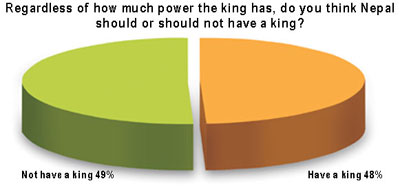

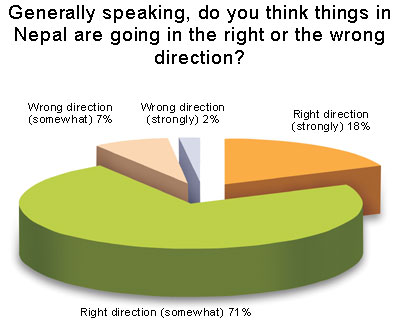
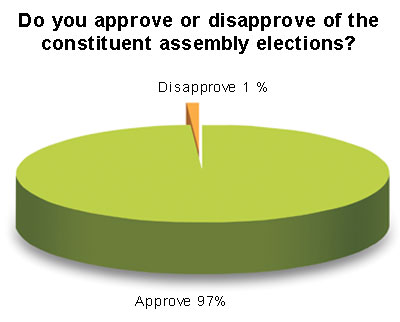
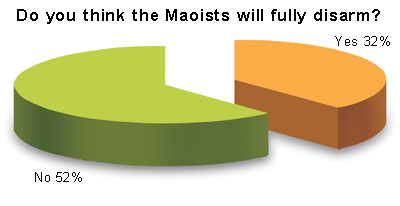
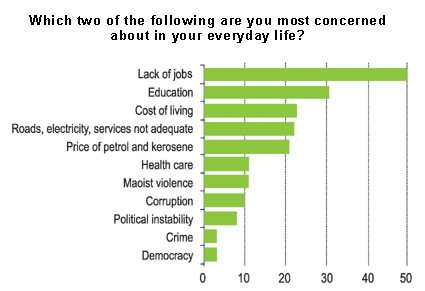
(The pie charts do not include \'Don\'t know/ Can\'t say\' responses)
Optimism, certainty, and ambivalence
It may be a bit premature to discuss an election to a constituent assembly when 35 percent of the electorate either hasn't heard about it or knows very little about it.
Even so, there are telling political and psephological patterns suggested by the NDI-AC Nielsen poll results released this week. There is cautious optimism about some things, dead certainty about others and ambivalence on the remaining. But that just reflects the contradictions already present among the parties, the Maoists, and the royalists.
The seven-party alliance may have a 91 percent approval rating, but that puts more pressure on them to perform. In the 2004 NDI survey, that figure was just 34 percent, which suggests that if the alliance doesn't manage the expectations of the people well, they could lose a lot of ground gained through the April Uprising.
Nepalis may be optimistic about the parties, but they aren't unrealistic. They see disunity (58 percent) and self-interest (33 percent) as the biggest stumbling blocks to the parties. Social inequity will play a role in how parties are judged, as 28 percent rated 'not doing enough for women and lower castes' as one of their two top concerns about the government.
The king has an abysmally low rating (-59 on a 'thermometer scale', which measures the spread between approval points going up to 100 and disapproval going down to -100). But the institution of the monarchy remains an issue, though republicans and royalists are split virtually down the middle, and by age, gender, education, and region.
Though the king's personal rating might have fallen considerably since 2004, nine percent still think he should have control of the army. John Moreira, head of the team that designed the questionnaire, suggests that support for the institution of monarchy will increase or decrease according to the personal role of the king in the coming days. This, he says, is because only 2 percent of the respondents back absolute monarchy as against the bulk who wish strictly ceremonial role for the king.
The Maoists for their part are faced with ambivalence. Their thermometer rating is -2, after positive ratings for the seven- party alliance, the UML, and the NC. The Maoists have got better ratings in helping the poor, fighting corruption, and stopping caste discrimination, and Pushpa Kamal Dahal's personal rating has gone to 35 percent. This support has the potential to grow during an election.
Thus, the undecided wait-and-watch respondents (18%), all potential voters in the constituent assembly election, could play a decisive in shaping the post-election scenario. Earlier polls by NDI and Himalmedia have shown that the Nepali people believe an election is a product of peace, not a precursor to it. This is possibly why even today 76 percent of respondents favour integrating Maoist troops into the Nepal Army.
.....
To conduct this survey, NDI commissioned polling research firm AC Nielsen and polling consultant US-based Greenberg Quinlan Rosner Research Inc, Washington DC, which predicts election results in countries like the US and the UK. Greenberg designed the polling survey, including the questionnaire, and analysed the data gathered. The Greenberg operation was directed by John Moreira, and AC Nielsen conducted the fieldwork. This entailed 10 focus group discussions, followed by random sampling based on the population break-up of 66 districts of Nepal. The survey's margin of error is 1.6 percent.


